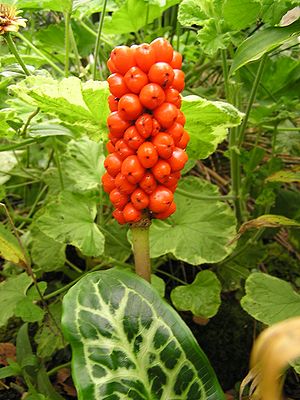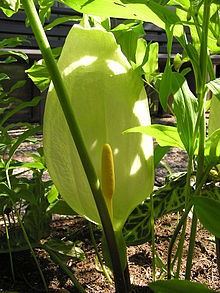Italian arum
| Italian arum | ||||||||||||
|---|---|---|---|---|---|---|---|---|---|---|---|---|

Italian arum ( Arum italicum ), infructescence. |
||||||||||||
| Systematics | ||||||||||||
|
||||||||||||
| Scientific name | ||||||||||||
| Arum italicum | ||||||||||||
| Mill. |
The Italian arum ( Arum italicum ) is a species of plant from the arum family (Araceae). The species is very rich in shape.
description
The Italian arum is an autumn-spring green, perennial , herbaceous plant that reaches heights of 20 to 80 centimeters. It forms a rhizome tuber. The stalked leaves drift in autumn; they have a length of 9 to 40 centimeters and a width of 2 to 29 centimeters. The leaf blades are arrow-shaped and usually have strikingly white leaf veins , are rarely spotted with black.
The Italian arum is single sexed ( monoecious ). The inflorescence consists of inflorescence stem, spathe and piston (spadix). The inflorescence stem is 15 to 40 centimeters high. The unisexual flowers are located on the lower part of a yellowish bulb, hidden under a single, green-whitish bract, which is called spathe in the arum family. The spathe is 11 to 38 centimeters long, white inside, whitish-green outside and often tinged with light purple on the edge. The male flowers are above the female. The male flowers are yellow before opening. Above and below the male flowers are numerous sterile flowers.
The flowering period extends from March to May.
The berries of the Italian arum are red.
The number of chromosomes is 2n = 84, less often 70.
Occurrence
The Italian arum is found in the Mediterranean region, in the Caucasus, in France in southern England in macchia , in Germany and grows in vineyards, olive groves, hedges and deciduous forests. Its distribution area includes Macaronesia and extends from Western Europe to Iraq.
Systematics
There are four subspecies of Arum italicum :
- Arum italicum subsp. italicum : The leaf veins are whitish, the spathe yellowish or greenish white. The number of chromosomes is 2n = 84. It occurs from the Mediterranean region to Iraq, in Great Britain and Switzerland.
- Arum italicum subsp. albispathum (Satven ex Ledeb.) Prime : The leaves are completely green, the spathe is white. The distribution area is the Crimea and the area from northeast Turkey to the Caucasus. The number of chromosomes is 2n = 84.
- Arum italicum subsp. canariense (Webb & Berthel.) PCBoyce : It occurs in Macaronesia.
- Arum italicum subsp. neglectum (F.Towns.) Prime : It occurs in north-west Africa, north-west Spain, western France, and southern Great Britain.
ingredients
In Italian Aronstab are calcium oxalate - crystals , soluble salts of oxalic acid and other pungent materials included. The plant is poisonous, which is probably due to the ratio of free to crystalline bound oxalic acid. In the unripe fruits the content of soluble oxalates is up to 0.4%, in the ripe fruits up to 0.3%.
use
The Italian arum is widely used as a fruiting ornamental plant for groups of trees and shady areas. It has been in culture since 1683 at the latest. The 'Pictum' ('Marmoratum') variety has marbled leaves.
supporting documents
Individual evidence
- ↑ a b c Tropicos. [1]
- ↑ a b c d e Rafaël Govaerts (Ed.): Arum. In: World Checklist of Selected Plant Families (WCSP) - The Board of Trustees of the Royal Botanic Gardens, Kew . Retrieved August 24, 2016.
- ↑ Rafaël Govaerts (ed.): Arum. In: World Checklist of Selected Plant Families (WCSP) - The Board of Trustees of the Royal Botanic Gardens, Kew .
- ↑ Flora Europaea
- ↑ The Italian Arum at www.giftpflanze.com
literature
- Eckehart J. Jäger, Friedrich Ebel, Peter Hanelt, Gerd K. Müller (eds.): Rothmaler excursion flora from Germany. Volume 5: Herbaceous ornamental and useful plants . Spectrum Academic Publishing House, Berlin Heidelberg 2008, ISBN 978-3-8274-0918-8 .
Web links
Web links
- Italian arum. In: FloraWeb.de.
- Distribution map for Germany. In: Floraweb .
- Arum italicum Mill., Map for distribution in Switzerland In: Info Flora , the national data and information center for Swiss flora .
- Distribution in the Netherlands [2] (Dutch)
- Thomas Meyer: Data sheet with identification key and photos at Flora-de: Flora von Deutschland (old name of the website: Flowers in Swabia )
- Entry in Plants for a Future. (engl.)
- On the pollination biology of the species described by the Düsseldorf Botanical Garden. (German)
